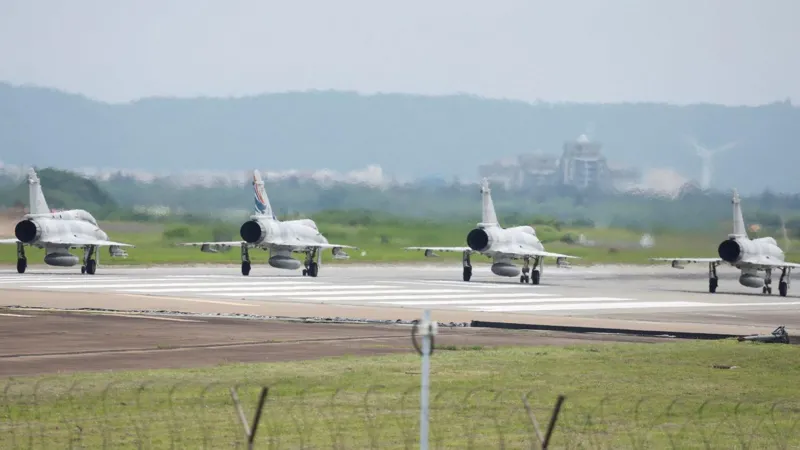What do China's drills around Taiwan tell us?
It's day two of China's military drills in the skies and seas around Taiwan - and the latest exercises show how the People's Liberation Army would surround the island on all sides by ships and aircraft.

It's a rehearsal of how Beijing would take the island, as it has vowed to do repeatedly.
China has already set a new normal in the Taiwan Strait, steadily ramping up miliatry pressure on the self-governed island.
So what is different about these drills - and what do they tell us?
Propaganda vs reality
It’s hard to tell exactly what is going on, but from what Beijing has made public, the areas covered by these drills are perhaps the biggest we’ve seen yet, and include much of the Taiwan Strait, the Bashi Channel (which separates Taiwan from the Philippines) and large swathes of the Pacific along Taiwan’s east coast.
Thursday's drills focused on encircling the island, simulating a full-scale attack, minus the actual landing of troops, Taiwan military expert Chieh Chung says.
He thinks the inclusion of all of Taiwan’s off-shore islands demonstrates China’s plan to eliminate facilities that could launch a counter-attack against the PLA.
He also thinks this two-day drill will not be the last Taiwan will have to endure this year – hence the name “Joint Sword 2024-A”. Friday's footage shows the People's Liberation Army (PLA) preparing for a mock strike on Taiwan’s main cities and ports.
A dramatic video released by the PLA’s Eastern Command, shows fleets of ships approaching Taiwan, accompanied by the words “Push in!” “Encircle!” “Lock!” .
The whole of Taiwan is then highlighted in orange – presumably indicating total control.
China has also released a video of a PLA colonel explaining the purpose of the drills in politically-charged language: "As we can see we have set two exercise areas in the sea and air space near the eastern part of the island, mainly to block the escape of 'Taiwan independence' separatists and break through their comfort zone," he says.
The island's eastern coast hosts crucial military infrastructure and because of its proxomity to Japan's southern islands, is also a reliable resupply route for Taiwan's allies, including the US.
But the reality is more prosaic. For one, China has released video of a group of coast guard ships approaching within three nautical miles of a Taiwan-controlled island called Wu-Qiu. This is a tiny rocky outcrop off the coast of Fujian. It’s only occupants are sea bird colonies and a small garrison of Taiwan soldiers.
On Thursday, Taiwan’s ministry of defence recorded 49 Chinese aircraft, 19 naval ships and seven coast guard vessels close to Taiwan’s territorial waters. The ships have largely been frigates and corvettes, which are smaller and carry a lighter weapon load.
There has been no sign of any Chinese heavy vessels such as amphibious assault ships or aircraft carriers taking part. A real invasion fleet would require much larger ships and much bigger numbers. The last time a major amphibious assault took place close to Taiwan was the US invasion of Okinawa in 1944. That US fleet had nearly 300 naval combatants, including 11 fleet carriers (large aircraft carriers) and hundreds of troop and supply ships.
Beijing's really doesn't like Taiwan's new president
Thursday's military drills were accomanied by a tirade against the man that Beijing said had triggered it all: William Lai, the island's new president.
The Global Times had already cast him as “arrogant” and “reckless”, and CCTV wrote that he "will certainly be nailed to the pillar of shame in history" and lambasted him for "selling the two-nation theory".
President Lai’s alleged crime is that in his inauguration speech on Monday he used the word China to describe China. Beijing says that in doing so Mr Lai revealed his true thinking that Taiwan is not China, and they are two different countries. It is, in their eyes, an admission of his “separatist” ideology.
To outsiders this may all sound absurd. But for decades Beijing and Taipei have obfuscated on their definitions of China, and whether Taiwan is part of it. Even former president Tsai was careful to refer to China in euphemistic terms like “the other side of the strait” or “the Beijing authorities”.
Some scholars in Taiwan will tell you such language is important, and that Mr Lai has crossed a dangerous line. Others say Beijing’s loathing for him was already set in stone and his speech has merely offered a rhetorical justification for the latest round of intimidation.
Most agree it doesn’t change the basic fact that Xi Jinping wants China to control Taiwan, and the people of Taiwan emphatically do not.
This is the new normal
But no-one in Taiwan is particularly surprised. To them, the Chinese Communist Party (CCP) is rather predictable. When Mr Lai’s Democratic Progressive Party (DPP) won a third consecutive presidential election here in early January, many wondered how and when Beijing would respond.
The obvious assumption was that it would be after Mr Lai’s term was inaugurated with his first presidential address. So here we are, four days after President Lai’s inauguration, and Beijing has issued a response.
The main clue that none of this is spontaneous is in the preparation. No military, not even the PLA can mobilise a drill on this scale in a matter of days.
Also worth noting is that so far China has repeatedly crossed the median line - an unoffcial border that is about 50 nautical miles out from both sides' shores. But it is yet to ever cross the contiguous zone, about 24 miles from Taiwan's shore. That would be seen as a major escalation. And it suggests that despite the aggressive rhetoric, Beijing is still being cautious.
Taiwan just chose a president China loathes. What now?
On the streets of Taipei the response to the drills has been a collective shrug. Many will tell you they are not worried. But that is not quite true. Living next to China is like living in an earthquake zone. The threat is always there and the drills are getting bigger and more dangerous, so you need to be prepared for it. But you also need to get on with your life.
Despite rancorous relations between Taiwan’s ruling DPP and the opposition – they have been brawling in parliament – the Chinese drills have brought all the parties together. The opposition KMT, which is traditionally seen as being pro-China, has called for Beijing to show restraint. This is not the time when they want to be seen as being friendly to Beijing.
There is a strange irony here - one that shows how little China’s communist leaders understand Taiwan and its people.
They have declared that the military operations are focused solely on “deterring and defeating independence forces”.
Every time China turns up the military intimidation, support for the DPP tends to rise, and that for the “China-friendly” KMT falls. A more recent case in point: months of military incursions in the lead-up to January’s election put Mr Lai in the top job.
If the aim is to frighten the people of Taiwan into turning away from parties and leaders who challenge Beijing, so far it seems to be having the opposite effect.
-bbc







